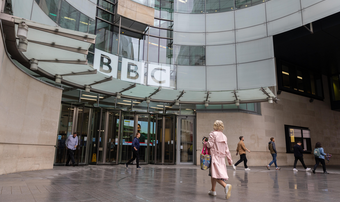Is there a quiet revival underway?

"Quiet Revival sweeps UK as church attendance soars" said one headline. 'Quiet Revival breaks Spiritual stillness in UK' said another article. Behind both headlines is a new report that is causing waves within British evangelicalism.
Based on interviews with more than 13,000 people, the Bible Society this week published A Quiet Revival which gives empirical data to back up what some have been saying for years, namely that there is a growing interest in Christianity.
The big headline is that contrary to the popular notion that church attendance is in permanent freefall, the church is growing! And it is growing especially thanks to 18-34 year olds with a fresh and new spiritual interest. More men are going to church and there is greater ethnic diversity as well.
It is worth summarising the key headlines because they are so encouraging:
- Church attendance up 50% in the last six years (the last time Bible Society completed similar research was in 2018).
- More men now attending church.
- Gen Z are showing real signs of spiritual hunger.
- 33% of all church goers are 18-34.
- 12% of adults in England and Wales attend church regularly with increased wellbeing being reported as a result.
This report suggests Jesus’ promise to build his church is true (Matthew 16:18)! It is a check to the narratives of constant decline. It highlights that church is not an institution only for older people – although there’s been an increase in church attendance among 65+ as well!
Test the spirits
How should we respond to all this? We should remember the command of 1 John 4:1: “Dear friends, do not believe every spirit, but test the spirits to see whether they are from God, because many false prophets have gone out into the world.”
This text is telling us to be discerning. This is not the same as being cynical. Such an attitude is sinful and inappropriate. There is a tendency among some of us to view every report of church growth with suspicion! Almost as if we take a perverse delight in decline.
Yet at the same time, we must avoid naivety and gullibility as well. The text warns us that false prophets and false, evil spirits are a reality. We cannot glibly assume everything we read and hear is true. Remember the words of Jesus as well: By their fruit you will recognize them. Do people pick grapes from thornbushes, or figs from thistles? (Matthew 7:16).
Therefore, it is appropriate and right that we look to assess what it reportedly going on and in a humble spirit, raise questions. After all, if this revival is fake, we should call it out and warn others. If it is real, we must praise God for what He is doing!
What is revival?
And the first question we must ask is what exactly a revival is? I am conscious that your answer to this might depend on the church tradition you come from. For example, if you are in more charismatic circles, I understand the word is used more frequently.
Think, for example, of the Hillsong song Hosanna, where we sing “I see a near revival coming as we pray and seek…’. There is a greater spirit of expectation and less surprise, I suggest, when revivals are reported than in some other church circles.
Yet we must not assume the concept is any less present in more 'reformed' circles. In fact, as someone who grew up in a reformed Baptist church in Edinburgh, barely a Sunday went by without mention of revival and prayers for God to pour out His Holy Spirit in a fresh demonstration of His power.
Yet let's assume you might not have come across the idea very often.
What exactly is it?
Pentecost as a pattern
Pentecost is where I think we should begin. This was the moment when the Holy Spirit was poured out in power from heaven, just as Jesus promised. The immediate result was divine power for the apostles and the conversion of 3,000 men and likely many more women and children as well. As you track through Acts, there are repeat moments where many are saved, alongside opposition and persecution. In Acts 3:19, Peter even urges repentance so that ‘seasons of refreshing’ may come upon his hearers. Some have taken this to mean revivals.
The point is that while Pentecost was a once and for all event, it serves as a prototype of revivals to come. Pentecost was the giving of the Spirit. He shall never depart fully now He has come. But, our relationship with the Spirit is dynamic. For example, we are commanded to be continuously filled with the Spirit. We are told not to grieve or quench him.
In other words, the Spirit can come in greater or lesser power upon us and upon communities. The salvation of 3,000 souls after Peter’s Pentecost sermon was the not always the result of the gospel preaching in the book of Acts. But there are moments where similar results are achieved.
An old hymn that starts “Revive your work O Lord” is helpful here. In one of the verses, you ask the Lord to send ‘Pentecostal showers’. This is a helpful way of thinking about revival. We do not pray for a new Pentecost, because that has happened. But we do pray for Pentecost-like moments and events.
Who it impacts
Another key feature of a revival is who it impacts. In a sermon on Ephesians 4:4-6, Dr Martyn Lloyd Jones, formerly the Minister at Westminster Chapel said that revival has two effects:
“Those on the inside of the church are raised up to a new level of experience and understanding . . . and those on the outside are converted and drawn in.”
This is the double effect of a revival (some would prefer the term ‘awakening’). We see it in Psalm 85:6 where the psalmist asks: “Will you not revive us again, that your people may rejoice in you?” And we have already mentioned the impact of preaching at Pentecost where souls are saved.
How does it happen?
How does it come about? Isaiah 40: 13-14 “Who can fathom the Spirit of the Lord, or instruct the Lord as his counsellor? Whom did the Lord consult to enlighten him, and who taught him the right way? Who was it that taught him knowledge, or showed him the path of understanding?”
Also John 3:8: “The wind blows wherever it pleases. You hear its sound, but you cannot tell where it comes from or where it is going. So it is with everyone born of the Spirit.”
Revival is a sovereign work of God’s Spirit. We cannot ‘magic’ it up, we cannot make it happen. It is not in human power to decide to hold a revival. This is why it is really tragic when perhaps well meaning Christians talk about holding a ‘revival’ service as if by human will alone we can make it happen.
The role prayer plays
That said, there is no doubt prayer plays a vital role. If you survey church history, you will notice that revivals are often preceded by God’s people praying for Him to act and to ‘make bear his mighty arm’.
This was true, for example, in a revival in 1857 in New York. It all started with a small prayer meeting that grew and grew until God answered and a genuine spiritual revival took place. The same can be said of the famous Welsh Revival of 1904-05.
Isaiah 62:6-7 gives us a picture of watchmen on the walls of Jerusalem whom the Lord instructs to give him no rest or peace until what? Until he makes ‘Jerusalem the praise of the earth’. This text comes in a chapter all about the power of Jesus and the beauty of the church. It is as clear a command as any that we should pray for God to send revival.
How can we tell real revival from fake?
To sum up, we could say that a revival is an extraordinary work of God, where in sovereign power he pours out the Spirit in a Pentecostal-shower which results in the lives of Christians being increasingly more holy and the salvation of many souls. Church history teaches us that revivals can be local, regional, national and sometimes even international.
But if we come back to the report of a quiet revival in Britain, how can we best assess it?
Truthfully we are not the first generation to grapple with this question. Church history is there so we can learn from the past, both from mistakes made by previous generations of believers and by their strengths as well.
One theologian from a previous era who gave considerable attention to revivals was Jonathan Edwards, the American pastor, thinker and preacher. He was in ministry during two distinct revival seasons. One between 1734-35 and the other between 1740-42.
During the latter one especially, critics arose who questioned the nature of the revival and especially the phenomena that accompanied it. So Edwards wrote Thoughts on the New England Revival to defend what he considered to be ‘the glorious work of God.’ It builds on his previous work Distinguishing Marks of a Work of the Spirit of God written about the revival of religion in 1735.
In his Thoughts on New England Revival, Edwards suggests 9 negative signs that even when present, do not necessarily indicate a genuine revival is taking place. The list is helpful because it helps us guard against labelling every new thing 'revival'. Edwards' list is as follows:
- that the work is carried on in an unusual or extraordinary way,
- that there are bodily effects such as tears, trembling and groans,
- that it results in a great deal of noise about religion,
- that great impressions are made on the imaginations of those who are influenced by it,
- that the example of others is a great means of bringing it about,
- that the subjects of it are guilty of great irregularities in their conduct,
- that there are many errors in judgement and even some delusions of Satan mixed up with the work,
- that some who were thought to be converted should fall away into serious errors or sins, and finally
- that it is promoted by ministers insisting very much on the terrors of God’s law.
As a counter, Edwards said the following are clear signs the revival is genuine:
- when the work is such as to raise the esteem of professed converts for Jesus and seems to establish their minds in the truth of the gospel testimony to Him as the Son of God and the Saviour of men,
- when the spirit that is at work operates against the interests of Satan’s kingdom, which lies in encouraging and establishing sin,
- when this spirit operates to bring about a greater regard to the Scriptures and establishes them more in their truth and divine origin,
- when that spirit operates as a spirit of truth, leading persons to the truth and convincing them of those things that are true, and lastly,
- when that spirit operates as a spirit of love to God and man.
Conviction of sin
Edwards helps us arrive at a balanced point that avoids both cynicism and gullibility. The third point in his list of five genuine signs of revival is especially relevant in assessing the Quiet Revival report because it tells us that even though church attendance is up, attitudes towards the Bible should give us some concern.
Jonathan Edwards said of the Northampton revival of 1734–1735 that while “God was so remarkably present amongst us by his Spirit, there was no book so delighted in as the Bible.”
Love for the scriptures is one sure sign of genuine conversion. After all, Jesus said ‘sanctify them by your word, your word is truth.’ (John 17:17). The report is right to commend the importance of discipleship. People are coming to church without any background in it at all. It is up to all of us who love Jesus to get alongside in a non-judgemental spirit to encourage them to follow Jesus.
Another sign we must look for is conviction of sin. This is what we see at Pentecost. We read that Peter’s listeners are ‘cut to the heart’ and ask what they must do. Jonathan Edwards again: “If we see persons made sensible of the dreadful nature of sin, and of the displeasure of God against it, and of their own miserable condition as they are in themselves by reason of sin, and earnestly concerned for their eternal salvation, and sensible of their need of God’s pity and help, and engaged to seek it in the use of the means that God has appointed, we may certainly conclude that it is from the Spirit of God.”
Our Ultimate Hope
So we must be careful to avoid two extremes. This report tells us that the spiritual landscape across the UK is shifting. Praise God for renewed spiritual hunger and interest! I hope it starts to filter through to our churches as we serve Jesus.
What we should look for is fruit that lasts. We want to see genuine conversions. It is good when new people come to church. But if all they want is increased wellbeing and community, these things are not the gospel, even if they are fruits that flow from belonging to Jesus!
We want to see conviction of sin and a longing for Jesus. We can be certain that when new believers read God’s word and love it, this is a genuine movement of God’s Spirit. Time will tell if these additional signs reveal themselves.
One final point. Our ultimate hope is not revival, but what revival contributes towards. Each revival accelerates spiritual life and brings our witness closer to what it should be. It ushers more souls into eternal life and brings us closer to the day when the earth is filled with the knowledge of God’s glory as the waters cover the sea (Habakkuk 2:14).
The ultimate hope is a new heavens and new earth. God uses revivals on the journey towards this future. But we must not despise a day of small things (Zechariah 4:10), because it is never a day of nothing at all.
I pray this quiet revival is the real deal. I praise God for renewed interest in Christianity. I pray we will disciple new believers and they will learn to love God’s word. I pray too for more revivals that will bring us closer to our ultimate hope of a brand new world.






